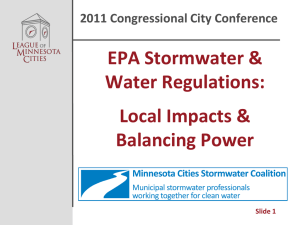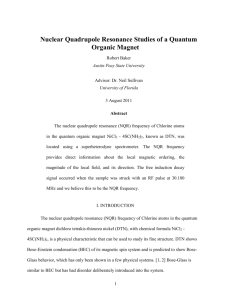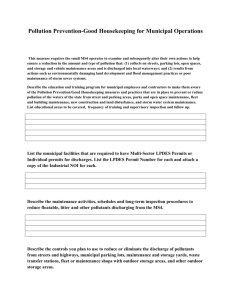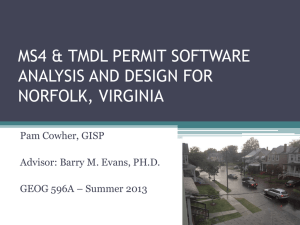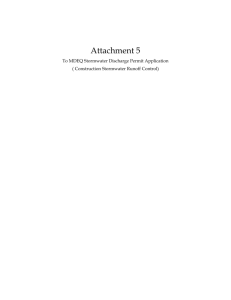Years 7 and 8 scope and sequence snapshot
advertisement
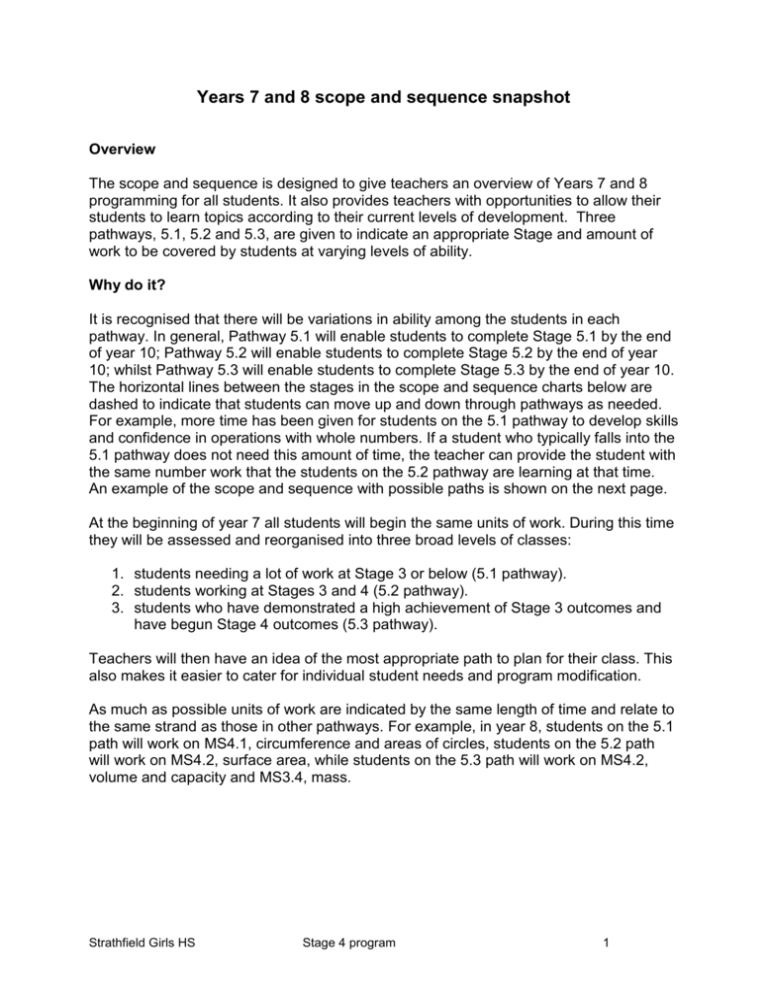
Years 7 and 8 scope and sequence snapshot Overview The scope and sequence is designed to give teachers an overview of Years 7 and 8 programming for all students. It also provides teachers with opportunities to allow their students to learn topics according to their current levels of development. Three pathways, 5.1, 5.2 and 5.3, are given to indicate an appropriate Stage and amount of work to be covered by students at varying levels of ability. Why do it? It is recognised that there will be variations in ability among the students in each pathway. In general, Pathway 5.1 will enable students to complete Stage 5.1 by the end of year 10; Pathway 5.2 will enable students to complete Stage 5.2 by the end of year 10; whilst Pathway 5.3 will enable students to complete Stage 5.3 by the end of year 10. The horizontal lines between the stages in the scope and sequence charts below are dashed to indicate that students can move up and down through pathways as needed. For example, more time has been given for students on the 5.1 pathway to develop skills and confidence in operations with whole numbers. If a student who typically falls into the 5.1 pathway does not need this amount of time, the teacher can provide the student with the same number work that the students on the 5.2 pathway are learning at that time. An example of the scope and sequence with possible paths is shown on the next page. At the beginning of year 7 all students will begin the same units of work. During this time they will be assessed and reorganised into three broad levels of classes: 1. students needing a lot of work at Stage 3 or below (5.1 pathway). 2. students working at Stages 3 and 4 (5.2 pathway). 3. students who have demonstrated a high achievement of Stage 3 outcomes and have begun Stage 4 outcomes (5.3 pathway). Teachers will then have an idea of the most appropriate path to plan for their class. This also makes it easier to cater for individual student needs and program modification. As much as possible units of work are indicated by the same length of time and relate to the same strand as those in other pathways. For example, in year 8, students on the 5.1 path will work on MS4.1, circumference and areas of circles, students on the 5.2 path will work on MS4.2, surface area, while students on the 5.3 path will work on MS4.2, volume and capacity and MS3.4, mass. Strathfield Girls HS Stage 4 program 1 Year 7 scope and sequence TERM 1 Week 2 Week 3 Week 4 Week 5 Week 6 Week 7 Week 8 Week 9 Week 10 Week 11 5.1 Staggered starts on SGS3.1 and MS3.5,MS4.3 with roman numerals (NS3.1) NS3.1, NS3.2, NS3.3 excluding roman numerals (Note: More in term 3) Staggered starts on SGS3.1, SGS4.1 and MS3.5, MS4.3 with roman numerals (NS3.1) NS3.1, NS3.2, NS3.3 excluding 5.2 Staggered starts on SGS3.1, SGS4.1 and MS3.5, MS4.3 with roman numerals (NS3.1) Last 4 points of NS4.1 + NS4.2 5.3 roman numerals + last 4 points of NS4.1 Note: Due to late start and interruptions, week 1 term 1 is not included TERM 2 Week 1 Week 2 Week 3 Week 4 5.1 SGS3.2b, SGS3.2a include parts of circles from end of SGS4.3 5.2 SGS3.2b, SGS3.2a, SGS4.2 include parts of Week 5 Week 6 Week 7 Week 8 Week 9 NS3.4 units 1 and 2 NS4.3 fractions to students ability + use of calculators NS4.1 except last 4 points NS3.4 units 1 and 2 fractions circles from end of SGS4.3 SGS4.2 and SGS4.3 5.3 notation, parts of circles and angles sums of triangles and quadrilaterals Indicates a student who struggles with geometry and who has good number skills and is completing more number work. Week 10 NS4.1 except last 4 points + NS5.1.1 excluding scientific notation Indicates a student coping in geometry, working at a faster pace in number and completing more complicated number work. NS4.3 Indicates a student who is strong in number and taking a slower pace in geometry. The process We looked at the sample program overviews given in the Advice on Programming and Assessment document from the Board of Studies (2001). The overview that we felt best catered for the majority of students coming to our school was for students who have not completed Stage 3 by the end of Year 6 but who can be expected to achieve Stage 5.2 outcomes by the end of year 10. (See page 10 Advice on Programming and Assessment). We have, at present, many students completing Advanced Mathematics in the School Certificate and Extension 1 Mathematics in the HSC but felt that the current students coming into year 7 still needed some of the Stage 3 work. This may need to change, in the future, as students begin the new syllabus in primary school. Strathfield Girls HS Stage 4 program 2 Initially we developed topic overview pages, often with a Stage 3 and 4 overlap. These contained the main content (for each Stage), prerequisite knowledge and skills, similarities or differences between the Stages, possible flow into Stage 5 or other work from Stage 4 in the same strand and links to other strands. An example of this is on page 4. We have bolded important concepts and aspects we needed to consider when programming. In particular, the outcomes in bold in the prerequisite column are Stages 3 and 4 outcomes, the same Stages that we were programming. We needed to consider whether to incorporate these concepts into the teaching of the unit we were working on or whether to teach the prerequisite concepts earlier in the program. Our decisions are listed at the bottom of the table. Topic overview pages were not developed for each topic. We had printed all pages from the syllabus as listed in the Year 7 and Year 8 columns of the overview and cut any large topics into smaller topics. For example, the Syllabus page containing NS4.3 Fractions, Decimals and Percentages was cut into the sub-topics fractions; decimals; percentages; and ratios and rates. This enabled us to look at the content, consider aspects from the topic overview pages and move the pieces of paper around to get a picture of the flow of the topics. The K-10 Mathematics continuum issued to all DET schools by the Professional Support and Curriculum Directorate, NSW Department of Education and Training, was used to look for links across strands or between different strands. While developing the scope and sequence we used the topic overview pages and syllabus pages to concentrate on the 5.2 pathway. When we were satisfied with this we looked at modifying this program to cater for students on the 5.1 and 5.3 pathways. As we completed the Year 8 scope and sequence we started planning for Years 9 and 10 to ensure continuity of the content. After completing the Years 7 and 8 scope and sequence we referred to the new Year 7 textbooks for content that matched our program. The comparisons are listed on page 11. Insufficient numbers of Year 8 textbooks were available to make this comparison. The scope and sequence and program order with pathway modifications for Years 7 and 8 are shown on pages 6 to 13. Strathfield Girls HS Stage 4 program 3 Topic overview – Sample page Outcome topic: Area/Perimeter and area Outcome code(s): MS3.2/MS4.1 Prerequisite knowledge and skills understanding of area units for measurement estimating area understanding of length, breadth, (perpendicular) height, width, base, distance using scales understanding of surface area nets and types of solids substitution understanding of perimeter Pythagoras’ Theorem?? Strathfield Girls HS Outcome code or Stage Stage 1 Stage 2 Stage 2 MS2.1 Knowledge and skills for that Stage Stage 3: realising need for km2 ha selection of appropriate units finding relationship between length and breadth for area of squares and rectangles and between base and perpendicular height for area of triangles in words using map scales to calculate area finding surface area of rectangular prisms by counting unit squares SGS3.3 MS4.2, SGS3.1, SGS2.1 PAS3.1a, PAS4.1 Stage 4: MS2.1 developing and using area formulae finding composite areas of triangles and MS4.1 rectangles developing formula for area of parallelograms converting area units solving problems combining area and perimeter information using Pythagoras’ Theorem to find areas of right triangles?? Stage 4 program Similarities and differences between stages 4 Stage 3 uses words to describe areas where as Stage 4 develops formulae Stage 3 finds area of squares, rectangles and triangles where as Stage 4 adds parallelograms MS4.1 does not mention surface area where as MS3.2 does. Surface area is covered in MS4.2 Possible flow into Stage 5 or other Stage 4 work in this strand MS5.1.1 developing formulae for areas of trapeziums, kites and rhombuses MS4.2 surface area of three-dimensional shapes Topics to be taught within this unit MS4.2 to level required to understand concept of surface area MS4.1 Pythagoras’ Theorem to be taught during term 1 year 8 Strathfield Girls HS Stage 4 program Topics to be taught prior to this unit SGS3.3 position using a variety of mapping skills SGS3.1 nets and types of solids to be taught in year 7 PAS3.1a and PAS4.1 algebraic techniques to be taught in year 7 5 Links to other outcomes SGS3.1 and SGS4.1 nets and types of solids PAS3.1a, PAS4.1, PAS4.2 algebra and substitution STRATHFIELD GIRLS HIGH SCHOOL TERM 1 Week 2 Week 3 Week 4 Year 7 scope and sequence Week 5 Week 6 Week 7 Week 8 Week 9 Week 10 Week 11 5.1 Staggered starts on SGS3.1 and MS3.5,MS4.3 with roman numerals (NS3.1) NS3.1, NS3.2, NS3.3 excluding roman numerals (Note: More in term 3) 5.2 Staggered starts on SGS3.1, SGS4.1 and MS3.5, MS4.3 with roman numerals (NS3.1) NS3.1, NS3.2, NS3.3 excluding roman numerals + last 4 points of NS4.1 5.3 Staggered starts on SGS3.1, SGS4.1 and MS3.5, MS4.3 with roman numerals (NS3.1) Last 4 points of NS4.1 + NS4.2 Note: Due to late start and interruptions, week 1 term 1 is not included TERM 2 Week 1 Week 2 Week 3 Week 4 SGS3.2b, SGS3.2a 5.1 5.2 5.3 include parts of circles from end of SGS4.3 SGS3.2b, SGS3.2a, SGS4.2 include parts of circles from end of SGS4.3 SGS4.2 and SGS4.3 notation, parts of circles and angles sums of triangles and quadrilaterals Week 5 Week 6 Week 7 Week 8 Week 9 Week 10 NS3.4 units 1 and 2, NS4.3 fractions to students ability + use of calculators NS4.1 except last 4 points NS3.4 units 1 and 2 fractions NS4.1 except last 4 points + NS5.1.1 excluding scientific notation NS4.3 NOTE: ADDITIONAL WEEKS HAVE BEEN INCLUDED IN THE SCOPE AND SEQUENCE TO ALLOW FOR ASSESSMENT AND DISRUPTIONS SUCH AS EXCURSIONS OR ASSEMBLIES. Strathfield Girls HS Stage 4 program 6 STRATHFIELD GIRLS HIGH SCHOOL Year 7 scope and sequence TERM 3 Week 1 Week 2 Week 3 Week 4 NS3.3+NS4.1 excluding special 5.1 NS4.3 fractions 5.3 include some of PAS4.1 for simple algebraic fractions Week 6 Week 7 NS4.3 fractions Week 8 NS4.1 DS4.1 (graphs) include picture graphs groups of numbers (note additional to term 1) 5.2 Week 5 Week 9 Week 10 PAS3.1a, PAS4.2 Special groups of numbers DS4.1 (graphs) include picture graphs NS4.2 PAS3.1a, PAS4.2 DS4.1 include picture graphs Additional number content PAS3.1a, PAS4.2 TERM 4 Week 1 Week 2 Week 3 Week 4 Week 5 Week 6 Week 7 Week 8 Week 9 5.1 PAS4.1 NS3.4 units 1 and 2-NS4.3 decimals PAS3.1b 5.2 PAS4.1 NS3.4 units 1 and 2, NS4.3 decimals PAS3.1b PAS4.1+ PAS3.1b 5.3 extend to harder fractional questions Strathfield Girls HS NS4.3 decimals and NS5.1.1 scientific notation Stage 4 program Week 10 PAS4.3 and PAS5.1.1 index laws 7 Year 8 scope and sequence TERM 1 Week 2 Week 3 Week 4 MS3.1, MS4.1 5.1 length, perimeter 5.2 MS3.1, MS4.1 length, perimeter, circumference 5.3 length, perimeter, circumference MS4.1 Week 5 Week 6 Week 7 Week 8 Week 9 Week 10 Week 11 NS4.3 percentages MS4.1 Pythagoras NS4.3 ratios and rates NS4.3 percentages MS4.1 Pythagoras NS4.3 ratios and rates NS4.3 percentages MS4.1 Pythagoras ratios and rates + additional content NS4.3 Note: Due to late start and interruptions, week 1 term 1 is not included TERM 2 Week 1 Week 2 5.1 SGS3.3 5.2 SGS3.3 5.3 SGS3.3 + additional content Week 3 Week 4 Week 5 Week 6 Week 7 Week 8 Week 9 PAS3.1b, PAS4.3, PAS4.4 simplified MS4.1 circle work area including circles PAS4.3, PAS4.4 MS4.2 surface area MS4.1 area including circles, MS4.2 surface area, MS5.1.1 PAS4.4, PAS4.5 volume and capacity MS3.2 MS3.2, MS4.1 Week 10 MS4.2, MS3.4 Note: Additional weeks have been included in the scope and sequence to allow for assessment and disruptions such as excursions or assemblies. Strathfield Girls HS Stage 4 program 8 TERM 3 Week 1 Week 2 5.1 DS4.1 statistical graphs 5.2 DS4.1 statistical graphs 5.3 DS4.2 statistics Week 3 Week 4 Week 5 Week 6 Week 7 Week 8 harder PAS4.3, PAS4.4 SGS4.2 SGS4.3 PAS4.5 PAS5.1.2 SGS4.3, SGS4.4 midpoint, gradient, length (notation, angle sums completed in Year 7) Week 9 Week 10 MS4.2 surface area, MS3.3, MS3.4 volume and capacity MS3.3, MS4.2, MS3.4 volume and capacity MS5.2.2 volume of prisms and pyramids TERM 4 Week 1 Week 2 Week 3 Week 4 Week 5 Week 6 Week 7 Week 8 5.1 DS4.2 simplified NS3.5 SGS4.1 5.2 DS4.2 NS3.5, NS4.4 SGS4.4 5.3 DS5.1.1 NS3.5, NS4.4 NS5.1.3 SGS5.2.2 Strathfield Girls HS Stage 4 program 9 Week 9 Week 10 Program order Year 7 5.2 Pathway 1. Three-dimensional Space (SGS3.1), Properties of Solids (SGS4.1). 2. Time (MS3.5, MS4.3) and roman numerals from NS3.1. Modifications to 5.1 Pathway To ease sharing of practical materials, some classes will start topic 2 first. 3. Whole Numbers (NS3.1). 4. Addition and Subtraction (NS3.2). 5. Multiplication and Division (NS3.3) and last 4 points of Operations with Whole Numbers (NS4.1). 6. Two-dimensional Space (SGS3.2b, SGS3.2a), Angles (SGS4.2) and include parts of circles from end of SGS4.3. 7. Operations with Whole Numbers (NS4.1 except for last 4 points). 8. Fractions and Decimals (Fractions NS3.4 units 1 and 2), Fractions, Decimals and Percentages (Fractions NS4.3). 9. Data Representation (Graphs DS4.1 and picture graphs from DS3.1). 10. Integers (NS4.2). 11. Patterns and Algebra (PAS3.1a), Number Patterns (PAS4.2), Algebraic Techniques (PAS4.1). Strathfield Girls HS Stage 4 program Modifications to 5.3 Pathway All classes will begin on the same work while assessment and rearrangement of classes is taking place. Teachers will need to cater for individual needs while getting to know the students. Some students may not complete SGS4.1. 3, 4, 5. More time is given for this in term 3. Last four points of NS4.1 to be included then. 6. Doesn’t include SGS4.2. 3, 4, 5. Problem solving relating to operations along with NS4.2 and the last four points of NS4.1. 6. SGS4.3 notation, angle sums of triangles and quadrilaterals are included in place of SGS3.2a and SGS3.2b. 7. Not treated here allowing for 7. NS5.1.1 index laws, extra time for fractions. excluding scientific notation is. 8. Not treated here. Students revisit 8. Simple algebraic fractions NS3.3 and include NS4.1 without are included (PAS4.1). special groups of numbers. 9. No modification. 9. Students complete all of DS4.1. 10. Students complete NS4.1. 10. Students complete Special groups of numbers only. additional number content as on p14 syllabus. 11. No modification. 11. PAS3.1b added. 10 12. Fractions and Decimals (Decimals SGS3.4 units 1 and 2), Fractions, Decimals and Percentages (Decimals SGS4.3). 13. Patterns and Algebra (PAS3.1b). 12. No modification. 14. Length (MS3.1), Perimeter and Area (Length and perimeter MS4.1 including decimal and fractional lengths). [If time, otherwise, first topic for year 8.] 14. See year 8 program order. 13. No modification. 12. NS5.1.1 scientific notation is included in place of NS3.4. 13. PAS4.3 is included in place of PAS3.1b. 14. See year 8 program order. . The following outcomes could not be located in the comparison of Year 7 topics to new texts: New Insight Maths New Century Maths Spectrum Connections Maths Quest Signpost Maths Zone NS3.1 and PAS3.1b PAS3.1b DS4.1 (graphs) DS4.1 (graphs) DS4.1 (graphs) DS4.1 (graphs) and PAS3.1b PAS3.1b All other outcomes listed in our Year 7 program seem to be in these Year 7 text books. Strathfield Girls HS Stage 4 program 11 Program order Year 8 5.2 Pathway 1. Length (MS3.1) and Perimeter and area (Length and Perimeter including circumference MS4.1). Revise work on year 7 fractions and decimals by including these in length and perimeter problems. 2. Fractions, Decimals and Percentages (Percentages NS4.3). 3. Perimeter and area (Pythagoras’ Theorem MS4.1). Relate back to perimeter. 4. Fractions, Decimals and Percentages (Ratios and Rates NS4.3). Modifications to 5.1 Pathway 1. Circumference is not included. Modifications to 5.3 Pathway 1. No modifications. 2. Simplify to meet students needs. 5. Position (SGS3.3). 5. No modifications. 6. Area (MS3.2) and Perimeter and area (Area including circles MS4.1). 6. MS4.1 is not included. 7. Algebraic Techniques (PAS4.3 and PAS4.4). 7. PAS3.1b is included. Simplified versions of PAS4.3 and PAS4.4 are included. 8. MS4.1 Circumferences and Areas of Circles is included in place of MS4.2. 9. No modifications. 2. Extend to meet students needs. 3. Extend to meet students needs. 4. Additional content, p 14 syllabus, such as Golden Ratio to be included. 5. Additional content, p 14 syllabus, such as navigation and orienteering to be included. 6. MS4.2 surface area and MS5.1.1 are included in place of MS3.2. 7. PAS4.5 is included in place of PAS4.3. 8. Surface Area and Volume (Surface area MS4.2). 9. Data Representation (Statistical graphs DS4.1). 10. Properties of Geometrical Figures (SGS4.3). Strathfield Girls HS Stage 4 program 3. Simplify to meet students needs. 4. Simplify to meet students needs. 10. SGS4.2 is included in place of SGS4.3 12 8. Volume and Capacity are included in place of surface area. MS3.4 is included. 9. DS4.2 is included in place of DS4.1. 10. SGS4.3 notation, angle sums of triangles and quadrilaterals completed in Year 7. SGS4.4 and SGS5.2.1 are included. 11. Linear Relationships (PAS4.5) 12. Volume and Capacity (MS3.3), Surface Area and Volume (Volume and capacity MS4.2) and Mass (MS3.4). 11. Harder versions of PAS4.3 and PAS4.4 are included in place of PAS4.5. 12. Surface Area is included in place of volume and capacity from MS4.2. 13. Data Analysis and Evaluation (DS4.2). 13. Simplified version. 14. Chance (NS3.5) and Probability (NS4.4). 15. Properties of Geometrical Figures (SGS4.4). 14. NS4.4 is not included. 15. SGS4.1 is included in place of SGS4.4. 11. PAS5.1.2 is included in place of PAS4.5. 12. Volume of square and triangular pyramids and other right prisms from MS5.2.2 is included in place of MS3.3, MS3.4 and MS4.2. 13. DS5.1.1 is included in place of DS4.2. 14. NS5.1.3 is included. 15. SGS5.2.2 is included in place of SGS4.4. Stage 4 topics to be completed in year 9 by students completing the minimum work on the Stage 5.1 pathway: NS4.2 revision of NS4.3 combining all components, fractions, decimals, percentages, rates and ratios rather than treating them separately NS4.4 PAS4.3 harder applications PAS4.4 harder applications PAS4.5 MS4.1 area MS4.2 volume and capacity SGS4.3 except for parts of circles SGS4.4 Strathfield Girls HS Stage 4 program 13 References New South Wales Board of Studies (2001), Mathematics Years 7-10 Syllabus: Advice on Programming and Assessment, Sydney. Strathfield Girls HS Stage 4 program 14

